Embark on a journey to explore the wonders of nature’s finest landscapes with our exclusive guide to the Top 5 Most Beautiful National Parks in The World.
From breathtaking vistas to awe-inspiring wildlife encounters, these pristine sanctuaries offer a glimpse into the unparalleled beauty of our planet.
Get ready to be swept away by the majestic wonders that await you in these extraordinary destinations.
Start your adventure now and witness the magic of these iconic natural wonders firsthand.
Discover, explore, and experience the world’s most stunning national parks like never before.
I. Introduction
Discover breathtaking beauty! Explore the Top 5 Most Beautiful National Parks in The World. Nature’s wonders await!
A. Importance of connecting with nature
In today’s fast-paced and technology-driven world, it is increasingly crucial for individuals to connect with nature.
Connecting with nature offers numerous benefits for our physical, mental, and emotional well-being. It allows us to escape the stress and demands of daily life, rejuvenate our senses, and gain a deeper appreciation for the world around us.
Nature has a remarkable ability to calm our minds, reduce anxiety, and improve our overall mood.
Studies have shown that spending time in nature can lower blood pressure, boost our immune system, and enhance cognitive function.
B. Overview of national parks as ideal destinations for nature exploration
When it comes to immersing ourselves in nature’s wonders, national parks stand out as exceptional destinations. These protected areas are designated to conserve and showcase the incredible diversity of natural landscapes, ecosystems, and wildlife.
National parks offer a unique opportunity to experience the beauty and power of the natural world firsthand. From majestic mountains and pristine lakes to lush forests and vast savannahs, each national park has its own distinct charm and treasures waiting to be discovered.
Exploring national parks allows us to disconnect from our daily routines and immerse ourselves in the tranquility and awe-inspiring beauty of nature.
Whether it’s hiking along scenic trails, camping under starlit skies, or encountering wildlife in their natural habitats, these experiences provide us with a sense of connection and harmony with the natural world.
National parks offer a sanctuary where we can disconnect from technology, breathe in fresh air, and appreciate the wonders of our planet.
In the following sections, we will delve into the details of five of the most beautiful national parks around the world, highlighting their unique features, diverse ecosystems, and the experiences they offer to those seeking to connect with nature.
Let’s embark on a journey to these extraordinary destinations and discover the magic that lies within each one.
5. Plitvice Lakes National Park, Croatia
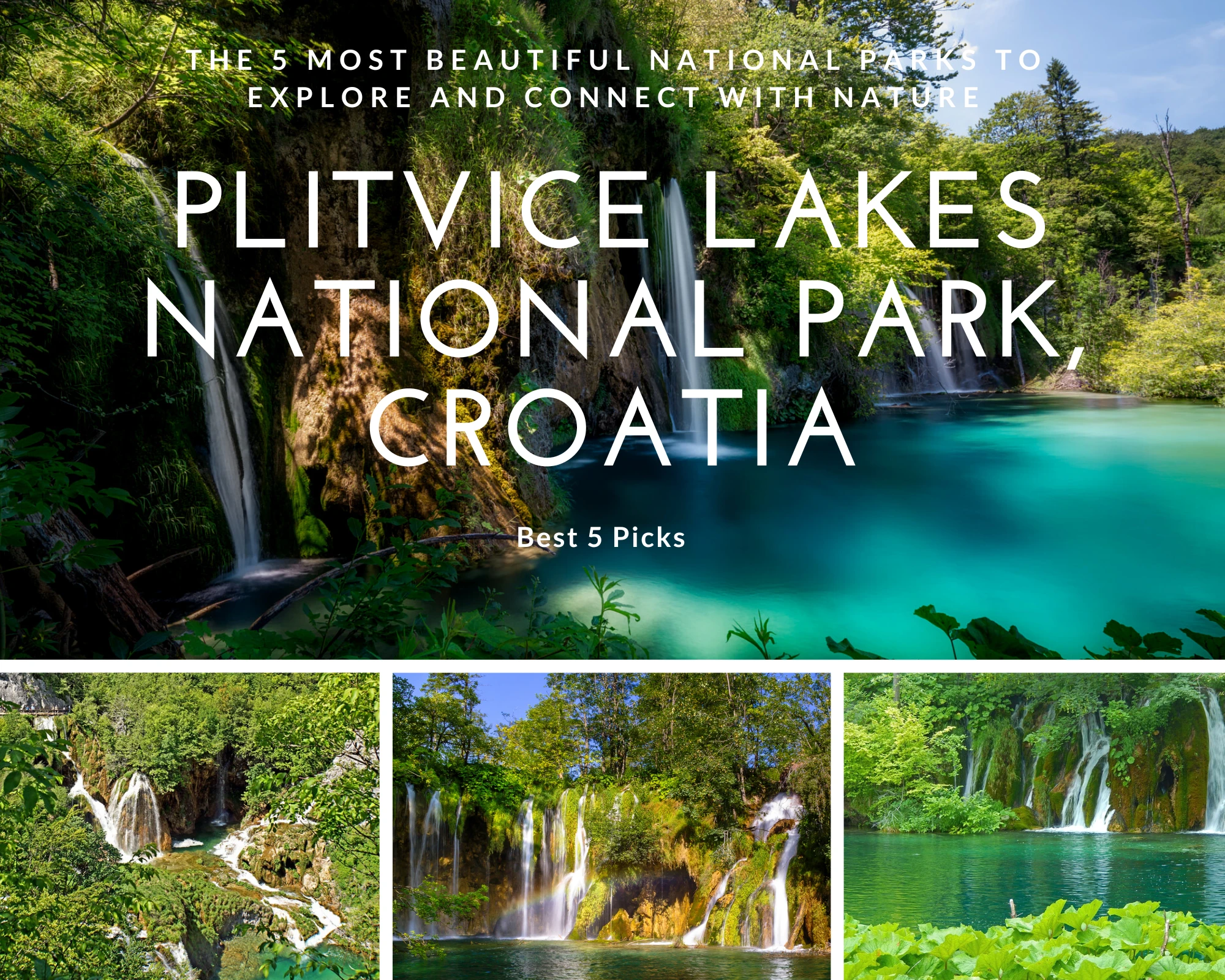
5.1 Overview of the park’s network of interconnected lakes and cascading waterfalls
Nestled in the heart of Croatia, Plitvice Lakes National Park is a breathtaking natural wonder that captivates visitors with its stunning network of interconnected lakes and cascading waterfalls. Spanning over 73,000 acres, the park is a UNESCO World Heritage site and one of the oldest national parks in Southeast Europe.
The park is characterized by its mesmerizing series of sixteen terraced lakes, each flowing into the next through a series of cascades and waterfalls. The crystal-clear waters of the lakes showcase vibrant shades of emerald, turquoise, and azure, creating a magical and ethereal atmosphere. The lakes are formed by the confluence of several rivers and underground karst rivers, resulting in a unique hydrogeological system.
The interconnected lakes are interconnected by a series of travertine barriers, which are formed by the accumulation of calcium carbonate from the flowing waters over thousands of years.
These natural barriers create a series of captivating waterfalls, ranging from small and gentle to grand and thunderous. The most famous among them is the Veliki Slap (Great Waterfall), which cascades down a height of 78 meters, making it the highest waterfall in Croatia.
5.2 Flora and fauna diversity, including rare species
Plitvice Lakes National Park is not only a haven for mesmerizing landscapes but also boasts a rich diversity of flora and fauna. The park is home to a variety of plant species, including beech, fir, spruce, and pine forests, which add to the park’s scenic beauty throughout the year. The lush vegetation provides a vibrant backdrop to the cascading waters, creating a picture-perfect natural paradise.
The park’s diverse ecosystem supports a wide array of wildlife, including several rare and endangered species. Among the notable animal species found in the park are brown bears, wolves, lynx, and various bird species. Visitors may be fortunate enough to catch a glimpse of these elusive creatures as they roam freely within the park’s protected boundaries.
One of the park’s most treasured inhabitants is the European brown bear, an iconic symbol of Croatia’s wilderness. The dense forests and abundant food sources make Plitvice Lakes an ideal habitat for these magnificent creatures. Additionally, the park provides a sanctuary for numerous bird species, such as the white-throated dipper, black stork, and golden eagle, making it a birdwatcher’s paradise.
The park’s dedication to conservation has led to the preservation of these fragile ecosystems and the protection of its rare and endangered species. Efforts are in place to ensure the park remains a safe haven for wildlife, with strict regulations in place to minimize human impact and maintain the delicate balance of nature.
Plitvice Lakes National Park in Croatia is a true natural gem, with its network of interconnected lakes and cascading waterfalls creating a surreal and awe-inspiring landscape. The park’s rich flora and fauna diversity, including rare and endangered species, further enhance its allure.
Whether you’re exploring the wooden pathways, sailing on the lakes, or simply immersing yourself in the serene beauty, Plitvice Lakes offers a unique and unforgettable experience for nature lovers and adventurers alike.
5.3 Wooden Pathways and Boat Rides for Experiencing the Park’s Natural Wonders
Nestled in the heart of Croatia lies the enchanting Plitvice Lakes National Park, a UNESCO World Heritage site renowned for its breathtaking beauty. What sets this park apart is its intricate system of interconnected lakes, cascading waterfalls, and lush greenery. To fully immerse yourself in the park’s natural wonders, the park offers wooden pathways and boat rides, allowing visitors to explore its unique landscapes in an unforgettable way.
As you enter the park, you’ll be greeted by a network of wooden pathways that wind their way through the park’s diverse terrain. These pathways are carefully designed to blend harmoniously with the surroundings, preserving the natural integrity of the area.
Walking along these pathways, you’ll feel a sense of tranquility as you meander through thick forests, across charming wooden bridges, and alongside crystal-clear lakes. The pathways offer different routes, catering to various fitness levels and time constraints, ensuring that visitors of all ages and abilities can enjoy the park’s wonders.
One of the highlights of Plitvice Lakes National Park is the boat rides offered on the park’s largest lake, Kozjak. These serene boat rides allow you to glide across the calm turquoise waters, providing a unique perspective of the park’s stunning waterfalls and emerald-hued lakes.
As you cruise along, the rhythmic sound of the oars hitting the water creates a soothing ambiance, and the cool breeze on your face adds to the refreshing experience. The boat rides offer an opportunity to witness the park’s beauty from a different angle, showcasing the grandeur of the waterfalls as they cascade down into the lakes below.
The wooden pathways and boat rides not only enhance your exploration of Plitvice Lakes National Park but also serve as a means to protect its fragile ecosystems. By providing designated pathways and limiting access to certain areas, the park minimizes human impact, ensuring the preservation of its natural wonders for generations to come.
The wooden pathways help prevent erosion and protect delicate plant species, while the controlled boat rides on Kozjak Lake prevent excessive disturbance to the wildlife and aquatic habitats.
To make the most of your visit, it’s recommended to follow the designated paths and adhere to park guidelines. These measures are in place to safeguard the park’s biodiversity and maintain the harmony between visitors and nature.
By practicing responsible tourism, we can contribute to the sustainable preservation of Plitvice Lakes National Park and enable future generations to experience its unparalleled beauty.
Plitvice Lakes National Park in Croatia offers a unique opportunity to connect with nature through its wooden pathways and boat rides. These immersive experiences allow visitors to witness the park’s captivating landscapes up close while ensuring the preservation of its delicate ecosystems.
Whether you choose to wander along the wooden pathways or embark on a tranquil boat ride, Plitvice Lakes National Park promises an unforgettable adventure that fosters a deep appreciation for the natural world. Let us embrace sustainable tourism and join hands in protecting this gem of nature for years to come.
4. Fiordland National Park, New Zealand
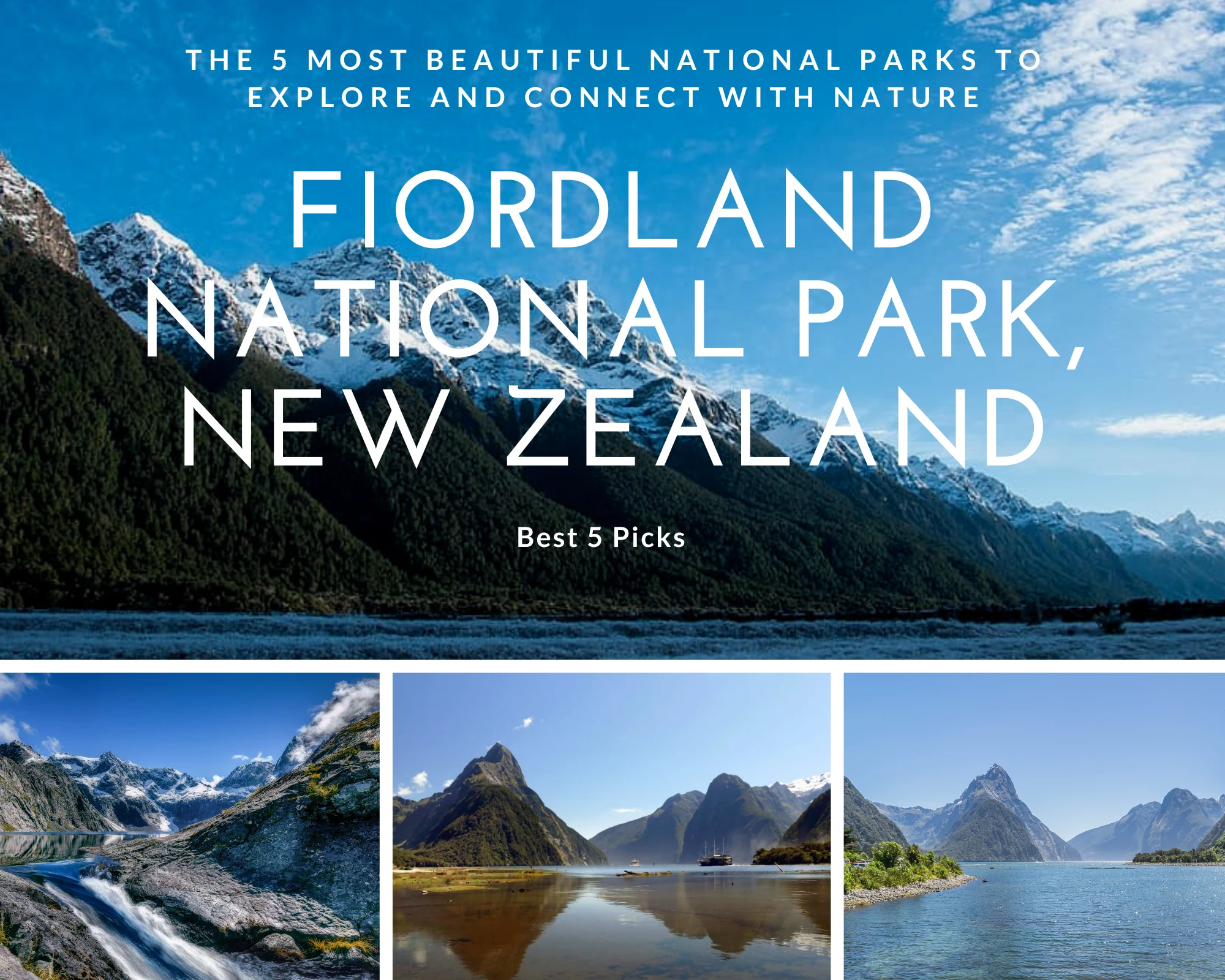
4.1 Description of the park’s stunning fjords, mountains, and rainforests
Fiordland National Park, located in the southwest corner of New Zealand’s South Island, is a place of unparalleled natural beauty. The park covers an area of over 1.2 million hectares and is renowned for its magnificent fjords, towering mountains, and lush rainforests. It is a UNESCO World Heritage site and offers visitors a truly awe-inspiring experience.
The park is dominated by its stunning fjords, including the famous Milford Sound and Doubtful Sound. These deep and narrow inlets were carved by glaciers millions of years ago and are surrounded by towering cliffs that rise dramatically from the water. The sight of these majestic fjords is simply breathtaking, with their serene waters reflecting the surrounding peaks and forests.
In addition to the fjords, Fiordland National Park boasts a range of impressive mountains. The park is home to the Southern Alps, which include prominent peaks like Mitre Peak and the Earl Mountains. These rugged mountains provide a dramatic backdrop to the already stunning landscape and offer opportunities for adventurous hiking and mountaineering.
The park is also characterized by its lush rainforests, which are some of the most pristine and ancient in the world. The dense vegetation includes a variety of native tree species, such as beech, rimu, and kahikatea. Walking through these verdant forests is like stepping into a fairytale, with moss-covered trees, vibrant ferns, and the soothing sound of trickling water from numerous streams and waterfalls.
4.2 Unique wildlife species like the endangered Fiordland crested penguin
Fiordland National Park is not only a haven for stunning landscapes but also a sanctuary for unique and endangered wildlife. One such species that calls this park home is the Fiordland crested penguin (Eudyptes pachyrhynchus). This remarkable bird is one of the rarest penguins in the world, with a population estimated to be around 2,500 individuals.
The Fiordland crested penguin is known for its distinctive appearance, with a striking yellow crest above its eyes, dark plumage, and a pinkish-colored beak. It is primarily found in the remote and inaccessible regions of the park, nesting in the coastal forests and rocky cliffs. These penguins are excellent swimmers and divers, using their streamlined bodies to navigate the waters in search of fish and squid, their primary sources of food.
Conservation efforts are underway to protect and preserve the Fiordland crested penguin. Measures such as predator control, habitat restoration, and monitoring of breeding colonies have been implemented to ensure the survival of this endangered species. Visitors to Fiordland National Park have the opportunity to observe these unique penguins in their natural habitat, but it is important to maintain a respectful distance to minimize disturbance.
The presence of the Fiordland crested penguin highlights the importance of Fiordland National Park as a crucial ecosystem for the conservation of endangered species. It serves as a reminder of the delicate balance between human activities and the preservation of these remarkable creatures and their habitats.
4.3 Milford Sound and its awe-inspiring beauty
Nestled within the breathtaking Fiordland National Park in New Zealand, Milford Sound stands as a true testament to the power and beauty of nature. Often regarded as one of the most stunning natural wonders in the world, Milford Sound offers a mesmerizing experience for those seeking to connect with the grandeur of the natural world.
Carved by ancient glaciers, Milford Sound is a fjord that stretches over 15 kilometers in length. Surrounded by towering granite cliffs that rise vertically from the dark waters, the landscape is truly awe-inspiring. The sheer scale of the mountains, reaching heights of over 1,200 meters, creates a sense of majesty that is difficult to match.
4.4 Activities like hiking the Milford Track and exploring Doubtful Sound
To truly immerse oneself in the splendor of Fiordland National Park, embarking on the renowned Milford Track is an unforgettable experience. Known as one of New Zealand’s Great Walks, this 53.5-kilometer trail takes hikers through a diverse range of landscapes, including ancient forests, pristine lakes, and alpine meadows. The track culminates at Milford Sound, offering hikers a triumphant arrival at the heart of this natural masterpiece.
For those seeking to explore beyond Milford Sound, a visit to Doubtful Sound is highly recommended. Although less accessible than its counterpart, Doubtful Sound offers a sense of pristine isolation and untouched beauty. Cruising through its tranquil waters surrounded by dense rainforests and cascading waterfalls is a truly serene and humbling experience.
4.5 Conservation initiatives to protect the park’s delicate ecosystems
Recognizing the immense value of Fiordland National Park’s delicate ecosystems, numerous conservation initiatives are in place to ensure their protection. The Department of Conservation (DOC) in New Zealand actively manages and monitors the park, working to preserve its unique biodiversity and natural heritage.
Strict regulations are in place to minimize the impact of human activities within the park. Visitors are encouraged to follow designated tracks and trails, refrain from littering, and respect the fragile flora and fauna. The DOC also implements predator control programs to safeguard native species from introduced predators such as stoats and rats.
Additionally, efforts are being made to raise awareness about the importance of sustainable tourism in Fiordland National Park. Local operators and tourism organizations strive to promote responsible practices, including minimizing waste, supporting local communities, and educating visitors about the fragile nature of the park’s ecosystems.
By combining conservation efforts with responsible tourism practices, Fiordland National Park aims to preserve its pristine beauty and ensure future generations can continue to marvel at the wonders of Milford Sound and the surrounding areas.
Fiordland National Park in New Zealand, with its crown jewel Milford Sound, offers an unparalleled opportunity to connect with nature’s magnificence. Whether hiking the Milford Track, cruising through Doubtful Sound, or simply admiring the awe-inspiring beauty of the fjords, visitors to this pristine wilderness are sure to be captivated.
Through ongoing conservation initiatives, Fiordland National Park strives to protect its delicate ecosystems and preserve its natural splendor for generations to come.
3. Serengeti National Park, Tanzania
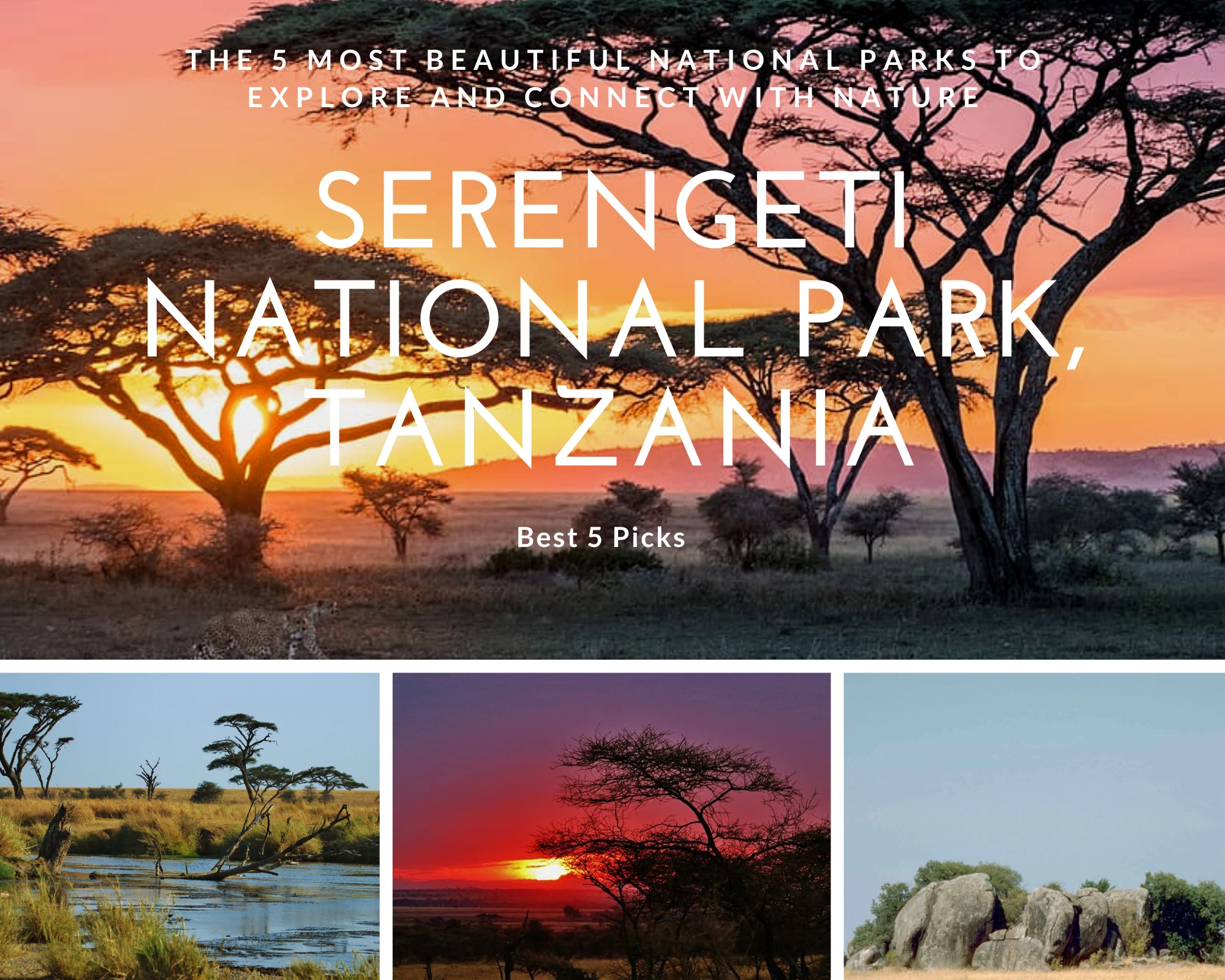
3.1 Introduction to the park’s vast savannah plains and remarkable wildlife
Serengeti National Park in Tanzania is a true gem when it comes to experiencing the untamed beauty of nature. Covering an expansive area of approximately 14,750 square kilometers (5,700 square miles).
The park is renowned for its vast savannah plains that stretch as far as the eye can see. This iconic landscape, with its golden grasslands and scattered acacia trees, creates a picturesque backdrop for an extraordinary wildlife spectacle.
3.2 The Great Migration phenomenon and its significance
One of the most awe-inspiring natural events that takes place in the Serengeti is the Great Migration.
This annual phenomenon involves the movement of millions of wildebeest, accompanied by zebras and gazelles, as they traverse the plains in search of fresh grazing and water sources. It is a mesmerizing display of nature’s grandeur and a testament to the survival instincts of these remarkable animals.
The Great Migration is a continuous cycle that follows a predictable pattern. It begins around December in the southern Serengeti, where the wildebeest give birth to their young, taking advantage of the nutrient-rich grasses.
As the dry season progresses, around June, the herds start their challenging journey northward in search of greener pastures. They brave treacherous river crossings, such as the Mara River, where they face hungry crocodiles and strong currents. The migration reaches its peak in July and August, when the herds gather in the northern Serengeti and spill over into the neighboring Maasai Mara National Reserve in Kenya.
The significance of the Great Migration extends beyond its sheer magnitude and visual spectacle. It plays a crucial role in maintaining the delicate balance of the ecosystem in the Serengeti.
The wildebeest, zebras, and gazelles help to aerate the soil, disperse seeds, and provide food for predators such as lions, leopards, and cheetahs. Additionally, the wildebeest’s grazing patterns help to regenerate the grasslands, ensuring their long-term sustainability.
Experiencing the Great Migration firsthand is an unforgettable experience. Witnessing the thundering hooves of thousands of wildebeest as they traverse the plains, listening to the cacophony of their calls, and seeing the predators lurking in the shadows is a true testament to the raw power and beauty of nature.
Safari tours and guided game drives provide opportunities to witness this extraordinary event up close and capture stunning photographs that will forever serve as a reminder of this natural wonder.
Conservation efforts in the Serengeti National Park are crucial to protect the habitat and wildlife that make the Great Migration possible. Wildlife monitoring, and community engagement initiatives are all part of ongoing programs to ensure the long-term survival of this extraordinary ecosystem.
Serengeti National Park offers an unrivaled opportunity to witness the vast savannah plains and remarkable wildlife of Tanzania. The Great Migration, with its awe-inspiring scale and significance, serves as a testament to the park’s natural wonders.
By visiting this incredible destination and supporting conservation efforts, we can ensure that future generations will have the privilege of experiencing the magic of the Serengeti.
3.3 Animal Species Found in Serengeti
The Serengeti National Park in Tanzania is renowned for its incredible biodiversity, boasting a rich variety of animal species that roam its vast plains. Here are some of the notable wildlife encounters one can experience in this remarkable park:
1. Lions:
Serengeti is synonymous with lions. The park is home to a significant population of these majestic big cats, offering visitors the opportunity to witness thrilling lion prides in their natural habitat. Whether they are lazing in the shade, hunting, or engaging in social interactions, observing lions in Serengeti is an awe-inspiring experience.
2. Elephants:
These gentle giants can also be found roaming the Serengeti. Known for their impressive size and intelligence, elephants leave a lasting impression on visitors. Watching them graze peacefully or witnessing their bathing rituals at watering holes is a sight to behold.
3. Zebras:
Serengeti is famous for its vast herds of zebras that migrate across the plains. These iconic black-and-white striped animals create a mesmerizing spectacle as they move in unison. The park provides ample opportunities to witness this incredible migration phenomenon up close.
4. Wildebeest:
The Serengeti is perhaps best known for the Great Migration, where millions of wildebeest, accompanied by zebras and other herbivores, journey across the plains in search of fresh grazing lands. This dramatic event attracts wildlife enthusiasts from around the world and is a true testament to the power of nature.
5. Giraffes:
With their long necks and graceful movements, giraffes can be spotted gracefully browsing on acacia trees in the Serengeti. Observing these magnificent creatures as they stretch their long necks to reach the treetops is a remarkable experience.
3.4 Safari Experiences and Hot Air Balloon Rides
To fully immerse yourself in the wonders of the Serengeti, embarking on a safari is an absolute must. Safaris offer the opportunity to explore the park’s diverse landscapes and encounter its wildlife up close. Experienced guides provide valuable insights into the park’s ecosystems and animal behavior, enhancing the overall safari experience.
Game drives in 4×4 vehicles are the most common way to explore the Serengeti. These guided tours take you through different regions of the park, offering ample opportunities for wildlife sightings. From open savannahs to riverbanks and woodland areas, each habitat presents unique wildlife encounters.
For an unforgettable perspective of the Serengeti’s vastness and beauty, hot air balloon rides are a popular option. Floating gently above the plains at sunrise, passengers are treated to breathtaking panoramic views of the park, with wildlife sightings from above. It’s an unparalleled experience that provides a true sense of the Serengeti’s grandeur.
3.5 Conservation Programs Addressing Challenges like Habitat Loss
1. Habitat Restoration:
Efforts to restore and rehabilitate degraded habitats are crucial for maintaining the park’s ecological balance. Restoration projects focus on combating invasive species, reforestation, and grassland regeneration. By restoring native vegetation, these programs help provide essential habitats for wildlife, enhance biodiversity, and support ecosystem functions.
2. Wildlife Corridor Protection:
Serengeti National Park is part of a larger ecosystem that extends beyond its boundaries. To ensure the long-term survival of migratory species like wildebeests and zebras, conservation programs prioritize the establishment and protection of wildlife corridors. These corridors enable animals to move freely between different areas, ensuring access to essential resources and promoting genetic diversity.
3. Research and Monitoring:
Continuous research and monitoring efforts play a vital role in understanding the park’s dynamics, identifying emerging threats, and informing conservation strategies. Researchers and scientists collaborate with park authorities to study animal behavior, migration patterns, and ecosystem health. This knowledge helps guide conservation actions and adapt strategies to address evolving challenges.
4. International Collaboration:
Recognizing the global significance of Serengeti National Park, international collaborations have been established to support its conservation efforts. These partnerships provide financial resources, technical expertise, and capacity building initiatives. They foster knowledge exchange, promote best practices, and help implement innovative conservation solutions.
2. Banff National Park, Canada
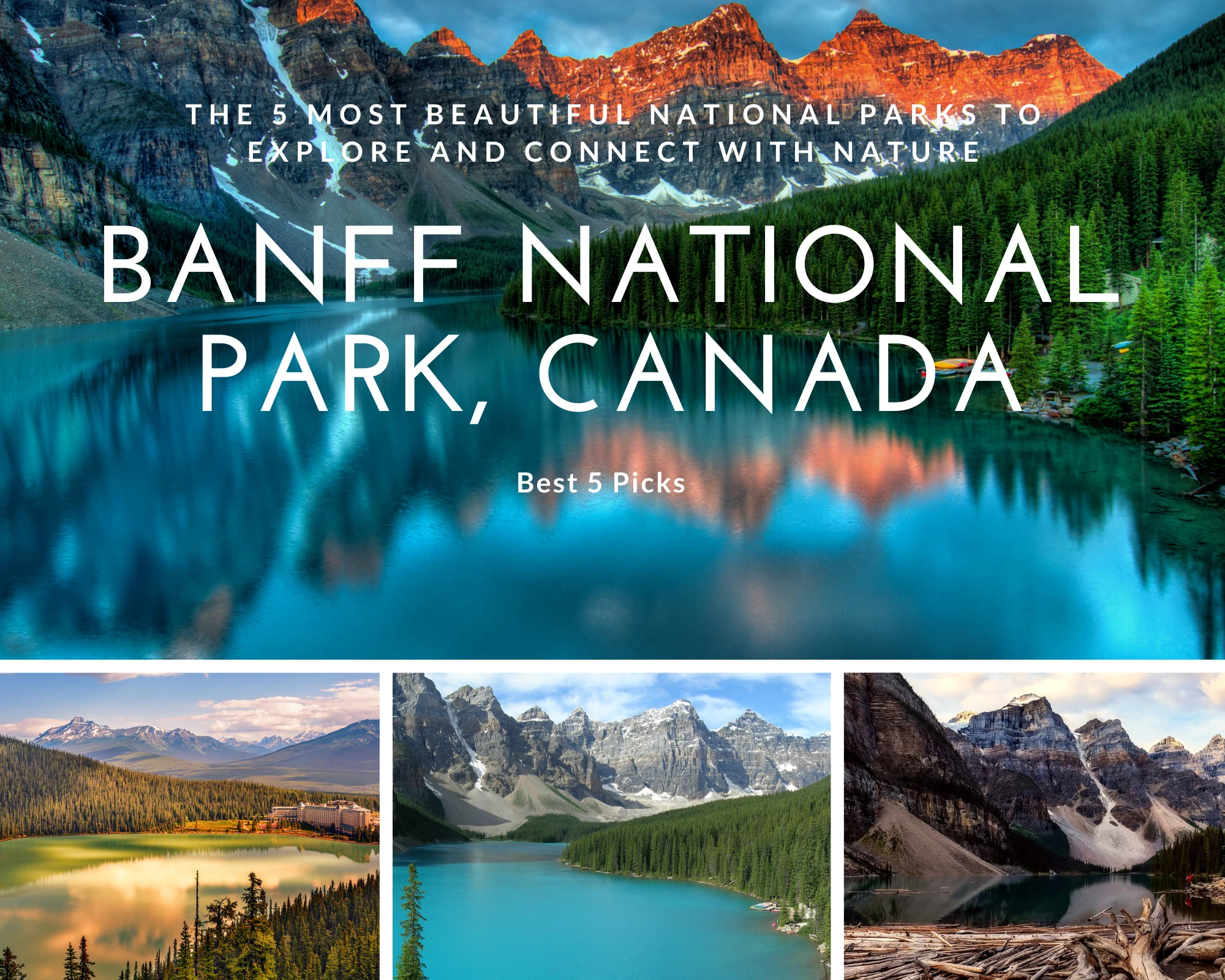
2.1 Description of the Park’s Breathtaking Mountain Scenery (e.g., Canadian Rockies)
Nestled in the heart of the Canadian Rockies, Banff National Park stands as a testament to the majestic beauty of nature. Its dramatic mountain scenery captivates visitors from around the world, offering a truly awe-inspiring experience. Towering peaks, rugged cliffs, and snow-capped summits create a picturesque backdrop that seems straight out of a postcard.
The park’s crown jewel is the Canadian Rockies, a sprawling mountain range that stretches across Alberta and British Columbia. Banff National Park showcases a significant portion of this stunning landscape, with peaks that soar to heights of over 3,000 meters (9,800 feet). The sight of these towering mountains, draped in blankets of snow or surrounded by vibrant autumn foliage, is a sight to behold.
2.2 Notable Features such as Glaciers, Turquoise Lakes, and Waterfalls
Within Banff National Park, visitors will find a plethora of natural wonders that add to its allure. Glaciers, remnants of ancient ice ages, dot the landscape and create breathtaking vistas.
Among the most famous is the Columbia Icefield, located in the park’s northern region. This massive icefield feeds numerous glaciers, including the Athabasca Glacier, which visitors can explore and marvel at its immense size and beauty.
Turquoise-colored lakes are another hallmark of Banff National Park. The most iconic of these is Lake Louise, known for its stunning emerald waters reflecting the surrounding mountains. The lake’s ethereal beauty attracts photographers, hikers, and nature enthusiasts year-round. Additionally, Moraine Lake, nestled in the Valley of the Ten Peaks, mesmerizes visitors with its vibrant turquoise hue and striking mountain backdrop.
Waterfalls are abundant throughout the park, cascading down rocky cliffs and adding a touch of elegance to the already breathtaking scenery. Among the notable waterfalls is the stunning Takakkaw Falls, which plummets 384 meters (1,260 feet) and is one of Canada’s highest waterfalls. The powerful rush of water and the mist that envelops the surrounding area create a truly enchanting atmosphere.
Exploring Banff National Park means immersing oneself in a world of awe-inspiring mountain scenery, where glaciers, turquoise lakes, and waterfalls weave together to create a symphony of natural beauty.
Each turn along the park’s trails reveals new vistas that leave visitors spellbound and yearning for more. Banff National Park truly stands as a testament to the grandeur of the Canadian Rockies and is an absolute must-visit destination for nature lovers and adventure seekers alike.
2.3 Abundance of Wildlife Species
Banff National Park in Canada is renowned for its incredible biodiversity and abundance of wildlife species. The park is home to a variety of animals, including grizzly bears, elk, and mountain goats, which thrive in its diverse habitats.
1. Grizzly Bears:
One of the most iconic and awe-inspiring creatures in Banff National Park is the grizzly bear. These majestic animals are known for their strength and beauty. Visitors to the park have the opportunity to catch a glimpse of these magnificent creatures in their natural habitat, particularly in the spring and fall when they are actively foraging for food.
2. Elk:
Another prominent resident of Banff National Park is the elk, also known as the wapiti. These large members of the deer family can often be spotted grazing in open meadows or near bodies of water. During the fall rutting season, male elks produce a distinct bugling sound and engage in elaborate displays to attract mates, creating a mesmerizing wildlife spectacle.
3. Mountain Goats:
Banff’s rugged mountain slopes are home to the nimble and sure-footed mountain goats. These sure-footed climbers can be observed effortlessly navigating steep cliffs and rocky terrain. Their impressive horns and white coats make them easily recognizable as they traverse the alpine landscapes.
2.4 Recreational Activities
Banff National Park offers a wide range of recreational activities that allow visitors to immerse themselves in the park’s stunning natural surroundings and encounter its abundant wildlife.
1. Hiking: With an extensive network of trails catering to different skill levels, hiking is one of the best ways to explore Banff National Park. From leisurely walks along picturesque lakeshores to challenging summit hikes, there is a trail for every adventurer. Hikers can expect breathtaking views of towering mountains, pristine valleys, and the chance to spot wildlife along the way.
2. Wildlife Spotting: The park provides excellent opportunities for wildlife enthusiasts to observe animals in their natural habitat. Visitors can embark on wildlife safaris or guided tours led by knowledgeable park staff or experienced local guides who can share insights about the park’s ecology and help spot elusive animals such as wolves, cougars, and lynx.
3. Skiing: Banff National Park is a winter wonderland, offering world-class skiing and snowboarding opportunities. With several ski resorts located within the park’s boundaries, visitors can enjoy thrilling downhill runs, cross-country skiing, and snowshoeing amidst breathtaking alpine scenery.
2.5 Efforts in Preserving the Park’s Ecological Integrity
Preserving the ecological integrity of Banff National Park is a top priority for park management and conservation organizations. Several initiatives and measures are in place to protect the park’s delicate ecosystems and ensure the long-term sustainability of its wildlife populations.
1. Wildlife Conservation: Banff National Park employs various strategies to protect its wildlife populations. This includes implementing measures to reduce human-wildlife conflicts, such as wildlife corridors and fencing along roadways, to minimize the risk of animal-vehicle collisions. Additionally, research and monitoring programs help assess the health of wildlife populations and inform conservation efforts.
2. Sustainable Tourism Practices: Recognizing the importance of sustainable tourism, Banff National Park promotes responsible visitation through educational initiatives and visitor guidelines. This includes educating visitors about wildlife safety, Leave No Trace principles, and the importance of minimizing the ecological footprint while exploring the park.
3. Habitat Restoration: To enhance and restore natural habitats within the park, ongoing restoration projects are conducted. These projects focus on reestablishing native plant species, controlling invasive species, and restoring critical habitats for wildlife, ensuring a healthy ecosystem for both resident and migratory species.
1. Yosemite National Park, United States
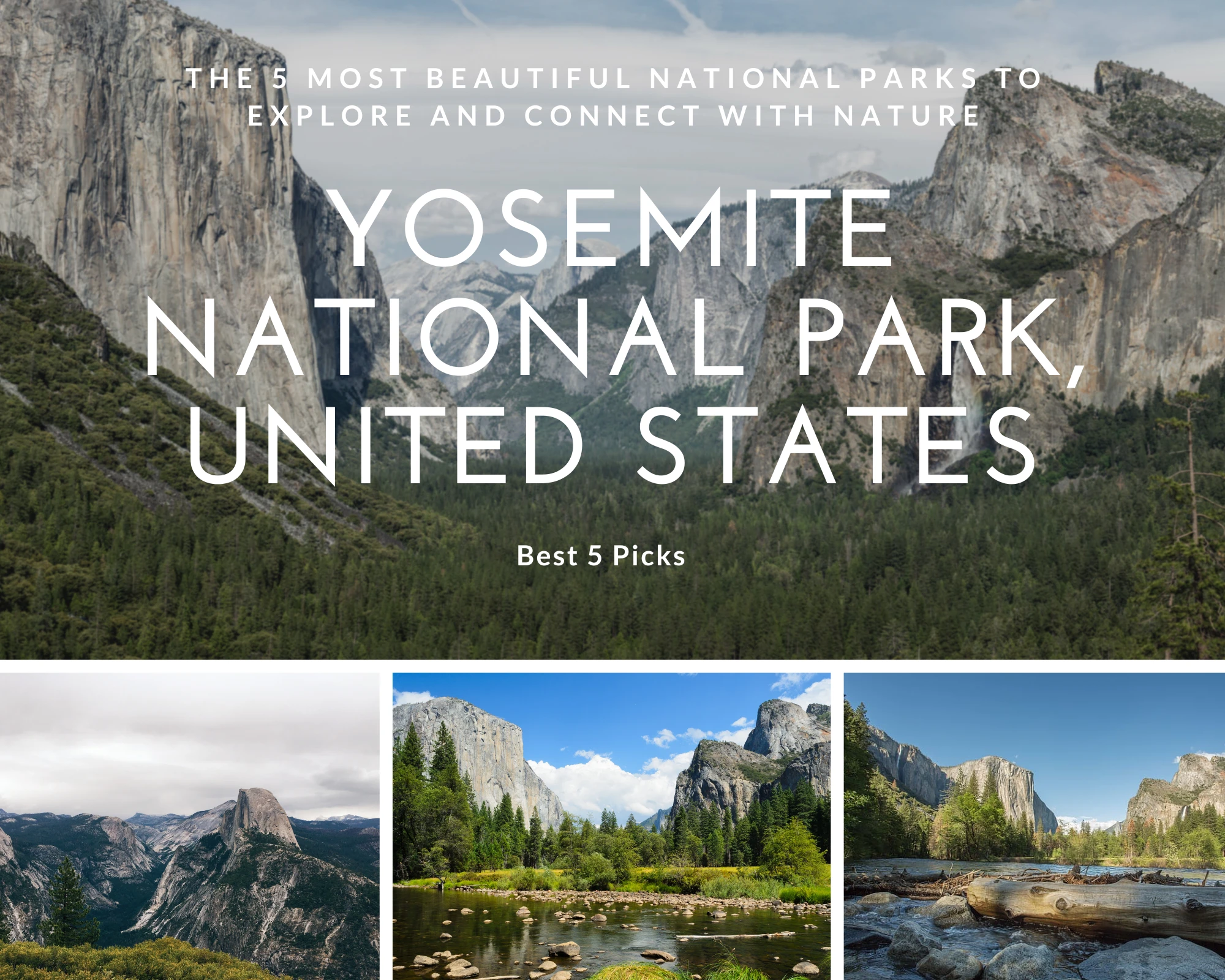
1.1 Description of the park’s iconic landscapes (e.g., Yosemite Valley, Half Dome, El Capitan)
Yosemite National Park, located in the western Sierra Nevada of California, is renowned for its breathtaking landscapes and iconic features that have captivated visitors for generations.
One of the park’s most famous destinations is Yosemite Valley, a glacially-carved wonderland surrounded by towering granite cliffs and cascading waterfalls. The sheer beauty of this valley, with its lush meadows and crystal-clear streams, leaves visitors in awe.
Among the prominent natural landmarks within Yosemite National Park is Half Dome, an iconic granite formation that rises nearly 5,000 feet above the valley floor. This majestic rock formation has become a symbol of the park and is a popular challenge for hikers who strive to reach its summit.
The hike to Half Dome provides not only a thrilling adventure but also rewards hikers with breathtaking panoramic views of the park’s landscapes.
Another iconic feature within the park is El Capitan, a massive granite monolith that stands as a testament to the park’s geological wonders.
Rising approximately 3,000 feet vertically from the valley floor, El Capitan is a mecca for rock climbers from around the world who come to test their skills on its sheer walls. Witnessing climbers ascend this towering monolith is an awe-inspiring sight that showcases the park’s adventurous spirit.
1.2 Highlighting diverse flora and fauna found in the park
Yosemite National Park is not only renowned for its majestic landscapes but also for its incredible diversity of flora and fauna. The park’s varying elevations and microclimates create a habitat for a wide range of plant and animal species.
Within the park’s forests, visitors can encounter towering sequoias, including the famous Mariposa Grove, which is home to some of the largest trees on Earth. These ancient giants, with their massive trunks and towering canopies, provide a sense of wonder and tranquility.
Yosemite’s meadows burst with vibrant wildflowers during the spring and summer months, painting the landscape with a kaleidoscope of colors. These meadows are not only aesthetically pleasing but also serve as crucial habitats for various animal species, including deer, black bears, and smaller mammals like squirrels and marmots.
The park’s rivers and streams support diverse aquatic life, including rainbow and brown trout, while its skies are adorned with a rich avian population. Birdwatchers can spot an array of species, such as golden eagles, peregrine falcons, and the rare great gray owl.
The unique ecosystem of Yosemite National Park provides a sanctuary for numerous species, many of which are threatened or endangered. Efforts to preserve the park’s biodiversity and protect its inhabitants are ongoing, making Yosemite a vital hub for conservation and research.
Yosemite National Park’s combination of awe-inspiring landscapes and diverse flora and fauna make it a must-visit destination for anyone seeking to connect with nature on a profound level. Whether exploring the iconic landmarks or immersing oneself in the park’s rich biodiversity, Yosemite offers an unforgettable experience that fosters a deep appreciation for the wonders of the natural world.
1.3 Outdoor activities and recreational opportunities available (e.g., hiking, camping, rock climbing)
Yosemite National Park in the United States offers a plethora of outdoor activities and recreational opportunities that allow visitors to immerse themselves in its natural wonders.
Here are some of the activities that make Yosemite a haven for nature enthusiasts:
1. Hiking:
Yosemite boasts an extensive network of trails that cater to hikers of all levels. From easy strolls to challenging multi-day treks, there is a hike for everyone. One of the most popular trails is the Mist Trail, which takes you past the stunning Vernal and Nevada Falls. The Half Dome hike, although demanding, rewards adventurous hikers with breathtaking panoramic views from its iconic summit.
2. Camping:
Yosemite offers various camping options for visitors who wish to spend the night amidst nature. There are numerous campgrounds throughout the park, ranging from developed sites with amenities to more primitive, backcountry camping experiences. Camping allows visitors to fully immerse themselves in the park’s tranquility, waking up to the sounds of birds chirping and the scent of pine trees.
3. Rock Climbing:
Yosemite is a world-renowned destination for rock climbers, attracting enthusiasts from all over the globe. The park features awe-inspiring granite walls and cliffs, including the famous El Capitan and Half Dome. Whether you’re a beginner or an experienced climber, Yosemite offers a wide range of routes and challenges for all skill levels.
4. Wildlife Viewing:
Yosemite is home to a diverse array of wildlife species, including black bears, mule deer, coyotes, and numerous bird species. Animal lovers can embark on wildlife viewing excursions to catch glimpses of these magnificent creatures in their natural habitats. It is essential to maintain a safe distance and respect the wildlife’s space and behavior while observing them.
5. Photography and Scenic Drives:
Yosemite’s landscapes provide endless opportunities for breathtaking photography. From the iconic Tunnel View to the serene meadows and towering waterfalls, every corner of the park is a picture-perfect postcard. Scenic drives, such as the Tioga Road and Glacier Point Road, offer stunning vistas accessible to all visitors.
1.4 Conservation efforts and initiatives in Yosemite National Park
Yosemite National Park is not only a place of immense beauty but also a symbol of conservation and environmental stewardship. The park is committed to protecting its natural resources and preserving its ecological integrity for future generations.
Here are some of the conservation efforts and initiatives in place:
1. Preservation of Wildlife: Yosemite actively monitors and manages its wildlife populations to ensure their long-term survival. The park conducts research, tracks animal populations, and implements measures to minimize human-wildlife conflicts. Efforts are made to protect endangered species, such as the Sierra Nevada bighorn sheep and the peregrine falcon.
2. Sustainable Practices: Yosemite National Park is dedicated to sustainable practices to minimize its ecological footprint. The park focuses on waste reduction, recycling programs, and energy conservation. Initiatives like green building design, water conservation measures, and alternative transportation options contribute to minimizing the park’s impact on the environment.
3. Habitat Restoration: Yosemite recognizes the importance of restoring and maintaining healthy habitats for its flora and fauna. The park engages in habitat restoration projects, such as meadow restoration, reforestation efforts, and invasive species management. These initiatives help preserve the park’s biodiversity and ensure the survival of native plant and animal species.
4. Education and Outreach: Yosemite actively promotes environmental education and outreach programs to raise awareness about the importance of conservation. Through visitor centers, interpretive programs, and guided tours, the park aims to inspire visitors to appreciate and protect its natural resources. Educational initiatives focus on topics like wildlife conservation, climate change, and Leave No Trace principles.
II. Conclusion
In conclusion, the world is blessed with an array of breathtaking natural wonders, and these top 5 national parks showcase the beauty and diversity of our planet’s landscapes.
These parks offer awe-inspiring experiences that remind us of the importance of preserving our natural heritage for future generations to enjoy.
A. Encouragement to Explore and Connect with Nature
These five national parks offer incredible opportunities to reconnect with nature and marvel at the Earth’s beauty. They provide a chance to escape the bustle of everyday life and immerse oneself in the tranquility and grandeur of natural landscapes.
Whether it’s hiking through breathtaking trails, observing diverse wildlife, or simply enjoying the serenity of untouched wilderness, these parks offer experiences that are bound to create lasting memories.
B. Emphasis on Responsible Travel and Conservation Efforts
As we venture into these national parks, it is crucial to prioritize responsible travel and conservation efforts. Respecting park rules and guidelines helps protect the fragile ecosystems and ensures the preservation of these natural wonders for future generations.
Additionally, supporting local conservation initiatives, practicing sustainable tourism, and raising awareness about the importance of conservation can contribute to the long-term well-being of these national parks.
III. Quick Recap of Top 5 Most Beautiful National Parks in The World
- Yosemite National Park, United States
- Banff National Park, Canada
- Serengeti National Park, Tanzania
- Fiordland National Park, New Zealand
- Plitvice Lakes National Park, Croatia
By exploring these beautiful national parks and connecting with nature, we not only enrich our own lives but also become advocates for the protection and preservation of our planet’s incredible biodiversity.
Let us embark on these journeys with a sense of wonder, appreciation, and a commitment to being responsible stewards of nature.
IV. Frequently Asked Questions (FAQ)
What makes Yosemite National Park in the United States so beautiful?
Yosemite National Park is renowned for its stunning granite cliffs, waterfalls, giant sequoia trees, and diverse wildlife. The park’s iconic landmarks like El Capitan and Half Dome draw visitors from around the world.
Why is Banff National Park in Canada considered one of the most beautiful?
Banff National Park is known for its breathtaking mountain scenery, turquoise lakes, glaciers, and abundant wildlife. Its picturesque towns like Banff and Lake Louise offer visitors a perfect blend of adventure and relaxation.
What sets Serengeti National Park in Tanzania apart as a beautiful destination?
Serengeti National Park is famous for its vast plains, where millions of wildebeest, zebras, and other animals migrate annually. Visitors are captivated by the park’s stunning sunsets, diverse ecosystems, and incredible opportunities for wildlife viewing.
What makes Fiordland National Park in New Zealand so visually stunning?
Fiordland National Park boasts spectacular fjords, rugged mountains, and lush rainforests. Its most famous attraction, Milford Sound, is renowned for its towering cliffs, cascading waterfalls, and abundant marine life.
Why is Plitvice Lakes National Park in Croatia considered a beautiful natural wonder?
Plitvice Lakes National Park is renowned for its series of cascading lakes, interconnected by stunning waterfalls and surrounded by lush forests. Visitors are enchanted by the park’s vibrant turquoise waters and picturesque landscapes.
When is the best time to visit Yosemite National Park?
The best time to visit Yosemite National Park is typically during the spring or fall when the weather is mild, and the crowds are fewer. However, each season offers its own unique beauty, so it ultimately depends on your preferences.
What activities can I enjoy in Banff National Park?
In Banff National Park, visitors can enjoy a wide range of activities such as hiking, skiing, snowboarding, wildlife viewing, boating, and soaking in natural hot springs. The park offers something for every outdoor enthusiast.
Are there any guided safaris available in Serengeti National Park?
Yes, there are numerous tour operators that offer guided safaris in Serengeti National Park. These safaris provide visitors with the opportunity to explore the park’s vast wilderness and observe its incredible wildlife up close.
How can I explore Fiordland National Park in New Zealand?
Visitors to Fiordland National Park can explore its stunning landscapes by taking scenic cruises through Milford Sound or Doubtful Sound, hiking on the park’s extensive network of trails, or embarking on multi-day wilderness adventures.
Are there accommodations available within Plitvice Lakes National Park?
Yes, there are several accommodations options within Plitvice Lakes National Park, including hotels, guesthouses, and campsites. Staying within the park allows visitors to experience its beauty at different times of the day and avoid the crowds during peak hours.










